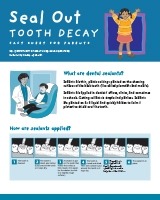Dental Sealants
On this page
Overview
Dental sealants are thin plastic coatings that protect the chewing surfaces of children’s back teeth from cavities, or tooth decay. The surfaces of these teeth are rough and uneven forming pits and grooves. Food and germs can get stuck in those pits and grooves and stay there for a long time because toothbrush bristles cannot brush them away. Sealants fill in the pits and grooves and keep the food out.
Children should get sealants on their permanent molars (back teeth) as soon as they come in, which is around six years for the first molars. The second molars appear around age 12. The sooner the sealants are placed, the less chance there is for decay to infect the surfaces of those teeth.
Sealants can be put on in a dental office, a community dental clinic, or in a school sealant program.
Placing sealants is simple and painless. They are painted on as a liquid and quickly harden to form a shield over the tooth.
Back to topHelpful Tips
- Ask a dentist or doctor where your child can get dental sealants. Sealants can be put on in a dentist’s office, a community health clinic, and sometimes at school.
- Some medical insurance (including Medicaid) and almost all dental insurance pay for sealants. Check with your insurance plan for details.
- Make sure your children also brush with a fluoride toothpaste twice a day and see a dentist for regular check-ups.
Additional Resources
- Dental Sealants Frequently Asked Questions
A fact sheet from the Centers for Disease Control and Prevention (CDC) that explains what sealants are, how they are applied, how long they last, and the benefits of sealants. - MedlinePlus: Dental Sealants
The NIH National Library of Medicine's collection of links to government, professional and non-profit/voluntary organizations with information on dental sealants.
September 2025

